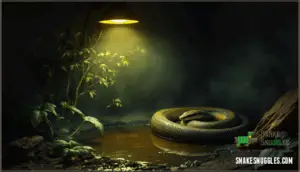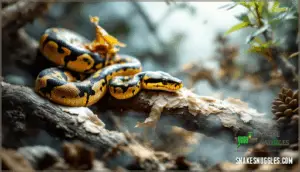This site is supported by our readers. We may earn a commission, at no cost to you, if you purchase through links.

By the time lethargy or appetite loss becomes obvious, your snake may already be fighting a serious infection, respiratory problem, or parasite load. Recognizing the early warning signs—changes in behavior, physical abnormalities, or environmental stress responses—can mean the difference between a quick recovery and a life-threatening crisis.
Table Of Contents
- Key Takeaways
- Recognizing Sick Snake Behavior
- Physical Signs of Snake Illness
- Common Health Issues in Snakes
- Respiratory Problems in Snakes
- Skin and Shedding Issues in Snakes
- Environmental Factors Affecting Snake Health
- Behavioral Changes Indicating Snake Illness
- Common Snake Diseases
- Parasitic Infections in Snakes
- Seeking Veterinary Care for Your Snake
- Frequently Asked Questions (FAQs)
- What are the signs of illness in snakes?
- How long do symptoms of rsv last?
- How do I know if my snake is ill?
- Can a snake get sick?
- Do snakes have health problems?
- How do you know if a snake has respiratory problems?
- What are the most common diseases in snakes?
- What do snakes do when they are sick?
- How do you know if you have a snake problem?
- Will a snakes respiratory infection go away on its own?
- Conclusion
Key Takeaways
- Snakes instinctively hide illness, so behavioral changes like refusing food for multiple feedings, prolonged lethargy, or unusual posturing often appear before physical symptoms and signal the need for immediate veterinary attention.
- Physical warning signs requiring urgent care include respiratory symptoms (wheezing, nasal discharge, open-mouth breathing), skin problems (lesions, scale rot, discoloration), and oral issues (mouth rot with cheesy discharge).
- Environmental factors like improper temperature, humidity levels, poor ventilation, or inadequate substrate directly cause or worsen most snake health problems, including respiratory infections that affect up to 68% of cases and metabolic bone disease in 80% of captive reptiles.
- Early veterinary intervention with a reptile-specialized vet is critical because conditions like respiratory infections, parasitic infestations, and bacterial infections progress rapidly—often becoming life-threatening within days if left untreated.
Recognizing Sick Snake Behavior
Your snake’s behavior tells a story, and spotting when something’s off can make all the difference. Changes in how your snake acts—from what it eats to how it moves—often appear before physical symptoms do.
Here are the key behavioral shifts that signal your snake needs attention.
Changes in Appetite or Feeding Habits
One of the first warning signs that something’s wrong with your snake is a sudden shift in its normal eating routine. If your snake refuses food for more than two consecutive feeding attempts, you’re looking at a potential problem. Appetite loss can signal stress, illness, or environmental issues.
Watch for food refusal coupled with regurgitation—that’s a red flag for digestive blockages or infections. Weight loss becomes noticeable within weeks of feeding behavior changes.
Appetite changes don’t always mean disaster, though. Some snakes naturally adjust their hunger cycles seasonally or before shedding. But when eating disorders pair with lethargy or other symptoms, it’s time to call your vet.
Altered Activity Levels or Lethargy
When your normally active snake starts moving like it’s wading through molasses, or you notice it spending hours in the same spot without much movement, something’s likely off. Lethargy paired with other symptoms demands attention.
Watch for these activity changes:
- Prolonged hiding beyond normal behavior patterns
- Weak or sluggish movements when touched
- Appetite loss lasting multiple feeding cycles
- Respiratory issues like labored breathing
Energy loss isn’t always dramatic—sometimes it’s just your snake feeling a bit off.
Unusual Posturing or Resting Positions
If your snake suddenly looks like it’s practicing yoga poses it never learned—head tilted skyward, body twisted at odd angles, or resting belly-up when it normally curls in a hide—you’re seeing more than quirky behavior. Stargazing behavior, abnormal coilings, and strange resting postures often signal neurological issues or severe discomfort.
Watch for poor body alignment, unusual snake stretching, or holding the head elevated to ease breathing. These animal behavior changes, especially paired with lethargy or appetite loss, indicate your snake needs immediate attention.
Don’t dismiss odd positioning as personality—these snake symptoms point to underlying reptile health problems requiring professional care.
Increased Aggression or Defensiveness
A normally docile snake that suddenly strikes without warning or coils defensively at every approach isn’t just having a bad day—it’s telling you something’s wrong. Pain from infections, parasites, or injuries often triggers aggression as a self-protection response.
Environmental influences like incorrect temperatures or inadequate hiding spots also create stress factors that alter animal behavior.
When your snake’s defensive posturing becomes the new normal, these behavioral cues signal it’s time for veterinary care to identify what’s causing the discomfort.
Physical Signs of Snake Illness
When your snake isn’t feeling well, its body often shows the problem before behavior changes become obvious. Physical symptoms can range from subtle skin changes to more alarming wounds or discharge.
Here’s what to watch for on your snake’s body that signals it’s time to call your reptile veterinarian.
Lesions, Wounds, or Open Sores
When you spot raw, open wounds on your snake’s body, you’re looking at a health crisis that won’t fix itself. Skin lesions and open sores invite bacterial infections that can spread quickly through damaged tissue. Snake abscesses may develop beneath the surface, creating pockets of infection you can’t see.
Dermatitis and scale damage often accompany these wounds, especially in damp or dirty enclosures.
Wound care requires immediate veterinary attention—your vet will assess tissue damage, prescribe antibiotics, and guide proper treatment. Meanwhile, isolate your snake, keep the environment clean and dry, and avoid touching the affected area.
Scales Coming Loose or Falling Off
Loose or missing scales aren’t just cosmetic—they’re your snake telling you something’s wrong. Scale loss causes range from shedding complications and fungal infections to bacterial skin lesions and mites hiding beneath damaged areas.
Snake skin conditions like scale rot thrive in damp, dirty environments, creating progressive scale damage you can’t ignore.
If you notice skin and scale abnormalities—patchy loss, discoloration, or scales lifting away—isolate your snake, improve enclosure hygiene, and schedule a veterinary visit promptly.
Discoloration, Blistering, or Swelling
Patches of odd color, raised blisters, or puffy swelling on your snake’s body are red flags waving for attention. These skin and scale abnormalities generally point to serious underlying problems:
- Blister disease from damp, unsanitary conditions causing fluid-filled lesions
- Skin infections (bacterial or fungal) creating scale damage and color changes
- Trauma or burns producing localized swelling symptoms and skin lesions
Don’t wait—these conditions worsen quickly without proper veterinary treatment.
Abnormal Odors or Discharge
If your snake’s enclosure suddenly reeks of something foul—or you notice unexpected oozing or discharge—your pet is likely dealing with an infection that needs immediate attention.
Nasal discharge and open-mouth breathing point to respiratory issues, while mucous from wounds suggests skin infections or even septicemia. Fungal infections produce musty odors and discolored discharge.
Don’t ignore these warning signs—they indicate your snake needs veterinary care now.
Changes in Eye or Mouth Condition
Your snake’s eyes and mouth serve as critical windows into its overall health, often revealing infections or systemic problems before other symptoms appear. Cloudy corneas or hazy, opaque eyes outside normal shedding cycles can signal eye infections requiring intervention. Mouth lesions, swollen gums, or oral discharge—especially the cheesy material characteristic of mouth rot (infectious stomatitis)—demand immediate veterinary attention.
Watch for these warning signs:
- Red and black specks around the mouth or nostrils indicating severe infection
- Persistent eye cloudiness unrelated to shedding schedules
- Thick, discolored discharge from the oral cavity suggesting bacterial overgrowth
Don’t wait—these symptoms escalate quickly.
Common Health Issues in Snakes
Snakes face several health challenges that range from easily treatable to life-threatening. Understanding these common conditions helps you recognize problems early, when treatment works best.
Let’s look at the specific issues you’ll want to watch for in your snake.
Respiratory Infections and Pneumonia
Respiratory infections rank among the deadliest threats to captive snakes, with mortality rates climbing as high as 75% in affected collections. Watch for wheezing, labored breathing, or mucus bubbles at the nostrils—these breathing difficulties signal pneumonia or respiratory disease demanding immediate attention.
Snake respiratory infections stem from poor ventilation, incorrect humidity, and temperature imbalances that weaken your snake’s natural defenses. Infection control starts with proper snake ventilation and environmental conditions, preventing the bacterial and viral respiratory issues that can quickly turn fatal.
Understanding respiratory disease causes is vital for maintaining a healthy environment for your snake.
Mites, Ticks, and Other External Parasites
External parasites like Ophionyssus mites and ticks are among the most common—and dangerous—threats to captive snakes. Mite infestation can drain blood, causing anemia, lethargy, and even death if left unchecked. You’ll spot these tiny parasites crawling on your snake’s scales, often hiding beneath them or around the eyes. Ticks attach firmly to skin, usually on the dorsal surface or around the head.
Both parasites spread bacterial infections, making parasite control urgent. Treatment involves careful tick removal and targeted mite elimination—never ignore these skin parasites.
Regular snake hygiene, thorough enclosure cleaning, and quarantining new arrivals prevent these external parasites from taking grip. Effective reptile parasite control is vital for maintaining the health of your snake.
Internal Parasites and Worm Infestations
While mites and ticks crawl across your snake’s skin where you can see them, internal parasites like roundworms, hookworms, and protozoans operate in the shadows of the digestive system, stealing nutrients and weakening your snake from the inside out.
You’ll notice weight loss despite regular feeding, regurgitation, or mucus-filled feces—clear signs of worm infestation. Heavy parasitic load can trigger intestinal blockage or severe gastrointestinal damage.
Fecal testing identifies these parasites and their life cycle stage, allowing your vet to prescribe targeted deworming treatment that restores your snake’s gastrointestinal health.
Bacterial and Fungal Infections
Bacteria and fungi thrive in warm, moist environments—which means your snake’s enclosure can become a breeding ground for infections if conditions aren’t right. Infectious stomatitis, commonly called mouth rot, presents with cheesy discharge around the gums, while skin infections and dermatitis show up as redness, swelling, or foul-smelling lesions.
Proper snake hygiene and infection control—including regular substrate changes and disinfection—are your first defense against bacterial and fungal infections. Your vet will perform bacterial diagnosis through culture and sensitivity testing, prescribing targeted antibiotics or antifungals for effective microbial management and fungal prevention.
Metabolic Bone Disease and Nutritional Deficiencies
Beyond bacterial threats, nutritional deficiencies wreak havoc on bone health. Metabolic bone disease strikes up to 80% of captive reptiles fed improper diets, with calcium deficiency and vitamin D3 shortfalls destabilizing skeletal integrity.
Watch for these red flags:
- Weight loss despite regular feeding schedules
- Lethargy and reluctance to move or explore
- Loss of appetite or refusal of prey items
- Tremors, soft jawbones, or folded spine indicating severe nutrient imbalance
Dietary supplements and whole-prey variety prevent this silent deterioration.
Respiratory Problems in Snakes
Respiratory infections rank among the most serious health threats your snake can face, often progressing quickly if left untreated. You’ll need to recognize the early warning signs, understand what triggers these infections, and know how proper habitat conditions can prevent them.
Here’s what to watch for and why it matters.
Signs and Symptoms of Respiratory Infections
When your snake sounds like it’s breathing through a straw or you spot tiny bubbles near its nose, it’s time to take respiratory symptoms seriously. Respiratory infections often announce themselves with audible wheezing, gurgling, or soft clicking sounds during breathing.
You might notice open-mouth breathing as your snake struggles to get enough air, or see mucus discharge bubbling at the nostrils. Many snakes with respiratory disease keep their heads slightly elevated to ease breathing difficulties.
These respiratory signs often come alongside loss of appetite and lethargy, clear warning signs that airway obstructions or infection control issues need immediate veterinary attention.
Causes of Respiratory Issues in Snakes
Understanding what triggers respiratory infections in snakes helps you protect your pet from serious illness. Poor snake husbandry sits at the heart of most respiratory problems, with environmental factors playing the starring role.
- Temperature and Humidity Imbalances: Incorrect ranges weaken your snake’s immune system, with suboptimal temperatures linked to 68% of respiratory disease cases and improper humidity affecting 42% of snakes with respiratory symptoms.
- Bacterial Infections: Gram-negative bacteria like Pseudomonas and Klebsiella cause over 65% of primary bacterial infections in the respiratory tract, often thriving in dirty enclosures.
- Stress and Immunosuppression: Chronic stress from touching, overcrowding, or environmental changes suppresses immunity in 41% of affected snakes, opening the door to respiratory infections in snakes.
Importance of Proper Ventilation and Humidity
Your snake’s enclosure works like its lungs—if air can’t move freely and moisture sits stagnant, respiratory trouble isn’t far behind. Proper ventilation systems prevent bacterial buildup, while environmental monitoring keeps humidity levels between 40-80%, depending on species. Temperature regulation creates the thermal gradient your snake needs to fight off respiratory infections. Without air quality control, you’re setting the stage for snake respiratory infections and respiratory disease.
Screen tops with appropriate mesh sizes balance airflow with heat retention, stopping respiratory issues before they start.
Skin and Shedding Issues in Snakes
Your snake’s skin tells a story about its overall health, and problems with shedding often signal underlying issues that need attention. When humidity levels drop too low or infections take grip, you’ll notice incomplete sheds, discolored patches, or abnormal textures that differ from your snake’s normal appearance.
Let’s look at the most common skin and shedding problems you might encounter.
Patchy Shedding and Dry Skin
If your snake’s shed is coming off in patches instead of one smooth piece, something’s not right with their environment. This improper shedding usually signals low humidity or dehydration—both fixable problems that need attention before they escalate into serious skin lesions.
Watch for these signs:
- Dull, flaky scales with a papery texture
- Retained eye caps or tail shed
- Patches of old skin clinging to the body
- Increased rubbing behavior against rough surfaces
Proper humidity control is your first line of defense in reptile care, preventing dry skin and promoting healthy scale health during each shed cycle.
Scale Rot and Fungal Infections
Scale rot and fungal infections creep in quietly, thriving in damp, dirty environments that compromise your snake’s natural defenses. Watch for blisters, soft or discolored scales, and skin lesions that ooze or smell foul—these red flags demand immediate attention.
Poor substrate conditions and excessive moisture create breeding grounds for bacterial and fungal infections that can quickly spread.
Rot treatment and infection control start with improving snake hygiene: clean the enclosure thoroughly, replace soiled bedding, and adjust humidity levels. Don’t wait—these skin infections worsen fast. Consult your reptile care veterinarian for proper diagnosis and medication, as fungal prevention requires both environmental fixes and targeted treatment to restore scale health.
Ensuring Proper Humidity for Healthy Shedding
Getting humidity right makes the difference between a smooth, healthy shed and a frustrating struggle with stuck skin. Your snake’s shedding process depends on proper humidity control—aim for species-specific levels using these hydration methods:
- Monitor with a reliable hygrometer
- Mist enclosures during shedding cycles
- Provide humidity hides with damp substrate
- Use moisture-retaining bedding materials
- Adjust ventilation to prevent respiratory issues
Environmental factors directly impact skin health, and improper shedding signals deeper snake care problems requiring immediate attention.
Environmental Factors Affecting Snake Health
Your snake’s environment isn’t just about comfort—it’s the foundation of their health. When temperature, humidity, lighting, or habitat setup fall short, you’ll often see the first signs of illness emerge.
Let’s walk through the key environmental factors that can make or break your snake’s wellbeing.
Improper Temperature or Humidity Levels
Temperature and humidity aren’t just numbers on a dial—they’re the invisible architecture of your snake’s entire world. Improper temperature control or humidity management can prevent your snake from regulating its body properly, leading to thermal stress, dehydration, or respiratory issues.
Environmental monitoring is crucial because improper temperature weakens immune function, making your snake vulnerable to illness. Climate regulation through consistent health checks and proper enclosure setup prevents these silent threats, keeping your snake from needing veterinary care.
Inadequate Lighting or UVB Exposure
While temperature and humidity keep your snake’s body running smoothly, light plays a surprisingly overlooked role in their overall wellness. UVB lighting facilitates Vitamin D3 production, which is essential for proper calcium absorption and prevents calcium deficiency. Without adequate photoperiod effects and proper lighting cycles, your snake may develop lethargy, cloudy eyes, or improper shedding—early snake illness symptoms that can progress to metabolic issues or respiratory problems.
Essential lighting considerations:
- UVB exposure duration – 10-12 hours daily mimics natural cycles
- Bulb replacement – Every 6-12 months, even when still glowing
- Distance matters – Follow manufacturer guidelines for proper placement
- Species-specific needs – Diurnal snakes require more UVB than nocturnal species
Poor Substrate or Enclosure Conditions
The floor of your snake’s home matters just as much as the climate inside it—dirty bedding and cramped quarters create a breeding ground for infections that can quickly escalate into serious illness. Substrate quality directly impacts your snake’s skin health, while poor enclosure cleaning allows harmful bacteria and parasites to thrive. Regular veterinary care starts with parasite control and proper snake enclosure maintenance.
| Factor | Action |
|---|---|
| Substrate Quality | Choose appropriate materials that maintain humidity control without trapping moisture |
| Enclosure Cleaning | Spot-clean daily, deep-clean weekly to prevent bacterial growth |
| Ventilation Issues | Secure adequate airflow to prevent temperature fluctuations and respiratory problems |
Inadequate Hiding Places or Visual Barriers
Snakes don’t thrive in glass boxes—they need safe havens where they can retreat, decompress, and feel invisible when the world feels too big. Without adequate hiding places or visual barriers, environmental stress builds quickly, triggering lethargy, cloudy eyes, and aggression.
Your snake habitat should include multiple hides—one on the warm side, one on the cool side—to support proper thermoregulation. Thoughtful enclosure layout with varied visual barriers helps prevent chronic stress, a silent contributor to illness.
Recognizing snake illness starts with understanding that hiding place design isn’t optional—it’s essential for snake health and wellness.
Behavioral Changes Indicating Snake Illness
Sometimes, the smallest shift in behavior speaks volumes about what’s going on beneath the scales. Your snake’s daily routine becomes a reliable pattern—when that changes, it’s worth paying attention. Lethargy is often the first red flag. If your normally curious snake suddenly prefers prolonged hiding or barely moves when you’d expect exploration, something’s off. Think of it like a usually chatty friend going silent—it demands investigation.
When your snake’s familiar routine suddenly shifts—hiding more, moving less—it’s telling you something’s wrong, much like a normally chatty friend going silent
Feeding changes tell their own story. Refusing meals repeatedly or showing disinterest in prey they’d normally strike without hesitation can signal underlying illness or stress. Conversely, abnormal posture like "stargazing" (holding the head at odd angles) or persistent body tension indicates discomfort that needs immediate attention.
Watch for unexpected aggression too. A customarily docile snake becoming defensive outside breeding season often means they’re hurting or stressed.
These behavioral changes aren’t personality quirks—they’re your snake’s way of communicating distress. Social withdrawal, decreased responsiveness, and other stress signals deserve the same careful observation you’d give physical symptoms, because often, behavior changes appear before visible illness does.
Common Snake Diseases
While spotting behavioral and physical changes is vital, understanding the specific diseases that threaten your snake’s health gives you a head start on early intervention. Some conditions strike suddenly while others develop quietly over weeks, but knowing what to watch for can make all the difference.
Let’s examine three of the most common diseases you’re likely to encounter as a snake owner.
Infectious Stomatitis (Mouth Rot)
When your snake’s mouth looks like it’s been through a battle—reddened, swollen, or oozing thick discharge—you’re likely dealing with infectious stomatitis, better known as mouth rot. This bacterial infection stems from stress, poor husbandry, or trauma. Left untreated, it can progress to septicemia.
Watch for these warning signs:
- Oral lesions with thick, cheese-like discharge
- Visible swelling along the gum line
- Reluctance to eat or strike at prey
- Dental abscess formation around teeth
Snake mouthrot demands immediate veterinary care to prevent life-threatening complications.
Skin Infections
Your snake’s skin is its first line of defense, and when infections take grip, they can spread faster than you’d expect. Bacterial dermatitis and fungal issues often start as small blisters or discolored patches—what we call blister disease—then progress to deeper scale infections.
You’ll notice skin lesions, scales loosening or falling off, and sometimes a foul odor. These snake skin conditions demand immediate veterinary attention, as they can quickly lead to septicemia if left untreated.
Viral Diseases
Viral diseases represent some of the most challenging threats your snake can face. Inclusion body disease (IBD) strikes boids with devastating force—it’s invariably fatal, affecting boas and pythons of all ages. You’ll see neurological symptoms like stargazing, chronic regurgitation, and progressive wasting.
Other viral outbreaks include:
- Ophidian paramyxovirus (OPMV) causing severe respiratory distress and CNS symptoms
- Ferlavirus linked to high mortality in breeding facilities
- Serpentoviruses with infection rates reaching 37.7% in pythons
- Arenaviruses producing neurological disease, especially in juveniles
Mites frequently transmit these viral infections between snakes. Unfortunately, snake vaccines don’t exist for these diseases, and no effective treatments are available for conditions like IBD—making prevention through quarantine and biosecurity your best defense.
Parasitic Infections in Snakes
Parasites aren’t just a nuisance—they’re a genuine health threat, with studies showing infection rates between 21% and 71% in captive snake populations. Both internal and external parasites can compromise your snake’s immune system, leading to inflammation, weight loss, and even death if left untreated. Understanding parasite life cycles and transmission routes helps you stay one step ahead.
Here’s what you need to know about common snake parasite infections:
- Internal parasites like nematodes (roundworms) and protozoans cause gastrointestinal damage, with mixed infections appearing in nearly all affected snakes
- External parasites such as mites and ticks are often visible under belly scales, irritating skin and potentially spreading disease
- Parasite transmission happens through contaminated prey, poor quarantine practices, or direct contact with infected animals
Snake quarantine protocols are your first line of defense when bringing home new animals. Parasite diagnosis requires fecal testing using techniques like flotation or molecular methods, which detect infections in roughly 28-40% of samples. Once identified, anthelmintic therapy prescribed by your reptile veterinarian targets specific parasitic infections effectively. Don’t wait—early detection saves lives.
Seeking Veterinary Care for Your Snake
When you notice something’s wrong with your snake, finding the right veterinary care can feel overwhelming. Not all veterinarians have experience with reptiles, and the diagnostic process may be unfamiliar to you.
Here’s what you need to know about getting your snake the specialized care it needs.
Choosing a Reptile-Specialized Veterinarian
Not every vet knows reptiles inside and out, so finding one who specializes in these cold-blooded patients can make all the difference when your snake needs help. Look for veterinary credentials that include reptile experience or exotic animal certification. Ask about the clinic facilities—do they have appropriate equipment for reptile diagnostics? Check if they offer emergency services or can provide specialist referrals when needed.
A vet trained in veterinary medicine for reptiles understands their unique physiology and won’t treat your snake like a scaly dog. Quality veterinary care protects animal welfare, so don’t settle for general practice when expertise matters.
Diagnostic Tests and Procedures
Once you’ve found a reptile-savvy vet, they’ll likely run several diagnostic tests to pinpoint what’s wrong. Blood tests check organ function and infection markers like creatine kinase for muscle damage. Fecal exams detect internal parasites—studies show about 20% of snakes carry helminths. Imaging techniques like X-rays or ultrasounds reveal bone issues or organ abnormalities.
For respiratory signs, tracheal washes collect samples using sterile saline to identify bacteria or lungworms. PCR assays confirm viral diseases like inclusion body disease. These tools give your vet the full picture of your snake’s health.
Medication and Treatment Plans
After your vet pinpoints the problem through testing, they’ll design a treatment plan customized specifically to your snake’s condition. This might include antibiotics for bacterial infections, antifungals for skin issues, or antiparasitic medication to eliminate internal parasites.
Your veterinary guidance will cover medication types, proper dose administration, and treatment duration—generally ranging from days to weeks depending on severity. Pain relief may be necessary for wounds or inflammation.
Following recovery protocols closely guarantees the best outcome, so adhere to your vet’s instructions carefully. You’re a key partner in your snake’s healing process.
Hospitalization and Recovery Care
In severe cases, your snake may need to stay at the veterinary hospital for round-the-clock monitoring and intensive care. This hospitalization guarantees your pet receives proper veterinary support, including fluid therapy, medication administration, and temperature regulation.
Snakes with septicemia or severe respiratory infections often require this level of hospital care. Your vet will develop customized recovery plans and provide post-op care if surgery was necessary.
Throughout snake therapy sessions, specialists monitor essential signs and adjust treatments as needed, giving your snake the best chance at recovery from serious reptile diseases.
Frequently Asked Questions (FAQs)
What are the signs of illness in snakes?
If your snake refuses food, moves less than usual, or holds its head in odd angles, something’s wrong. Look for breathing changes, skin problems, or shifts in temperament.
These illness signs mean your snake needs a reptile veterinarian right away.
How long do symptoms of rsv last?
RSV in snakes isn’t the same childhood virus you’re thinking of. For respiratory infections in snakes, symptoms persist one to three weeks depending on severity and treatment timing.
You’ll notice labored breathing, mucus discharge, and lethargy throughout the illness timeline. Prompt veterinary care shortens the recovery period.
How do I know if my snake is ill?
Look for key illness warning signs like refusing food, acting sluggish, or staying hidden constantly. Check your snake’s posture—abnormal stances signal trouble.
Watch for shedding problems, discharge from the mouth or eyes, and labored breathing. Swift action keeps your snake healthy.
Can a snake get sick?
Absolutely—snakes aren’t immune to illness, despite their reputation for resilience. Like any living creature, they can develop respiratory infections, parasitic infestations, bacterial infections, and metabolic disorders. Watch for lethargy, abnormal shedding, unusual postures, or breathing changes.
Maintaining proper humidity, temperature, and cleanliness prevents many snake illnesses, but veterinary care remains essential when symptoms appear.
Do snakes have health problems?
Like all animals, snakes face various health problems that require attention. Respiratory infections, parasitic infestations, and metabolic bone disease are common concerns that can seriously impact your snake’s wellbeing if left untreated.
How do you know if a snake has respiratory problems?
Breathing problems sneak up quietly, then hit hard. Watch for subtle wheezing, soft clicks when your snake breathes, or open-mouth breathing that looks like constant yawning.
Nasal discharge, mucus bubbles around nostrils, and head elevation while resting signal respiratory infections requiring immediate veterinary attention.
What are the most common diseases in snakes?
Snakes commonly face infectious stomatitis (mouth rot), respiratory infections, parasites like mites and worms, blister disease from poor husbandry, and inclusion body disease.
Spotting early signs of a sick snake—open-mouth breathing, visible mites, discolored scales—helps you get treatment fast and gives your snake the best shot at recovery.
What do snakes do when they are sick?
Your snake might stop eating, retreat more than usual, or move less often. These illness indicators point to trouble—lethargy, loss of appetite, and weight loss are classic signs of a sick snake.
Behavioral shifts signal distress, so don’t wait to seek veterinary advice.
How do you know if you have a snake problem?
When keeping pet snakes, you’ll spot potential problems through regular Snake Health Checks. Watch for Feeding Issues, unusual Lethargy, Loss Of Appetite, Weight Loss, or signs of Dehydration—these Behavioral Alerts signal your snake needs attention immediately.
Will a snakes respiratory infection go away on its own?
No, respiratory infections in snakes rarely resolve without treatment. These infections can quickly worsen, leading to pneumonia or septicemia.
Contact a reptile-savvy veterinarian immediately if your snake shows breathing issues—early veterinary intervention is vital for successful snake recovery and preventing life-threatening complications.
Conclusion
Your snake can’t tell you when something hurts—it simply withdraws, stops eating, and waits. That silence makes identifying snake illness symptoms critical.
Cloudy eyes, labored breathing, skin lesions, or unusual lethargy aren’t quirks—they’re distress signals. The moment you notice abnormal behavior or physical changes, contact a reptile-specialized veterinarian. Early intervention often means the difference between a treatable infection and a fatal decline.
Trust your instincts: if your snake doesn’t seem right, it probably isn’t.
- https://vcahospitals.com/know-your-pet/snakes-diseases
- https://www.petmd.com/reptile/care/evr_rp_how-can-i-tell-if-my-snake-sick
- https://www.petcoach.co/article/egg-binding-dystocia-in-reptiles-causes-signs-diagnosis-tre/
- https://pmc.ncbi.nlm.nih.gov/articles/PMC6786048/
- https://exoticskeeper.com/blog/understanding-respiratory-problems-in-snakes/



















